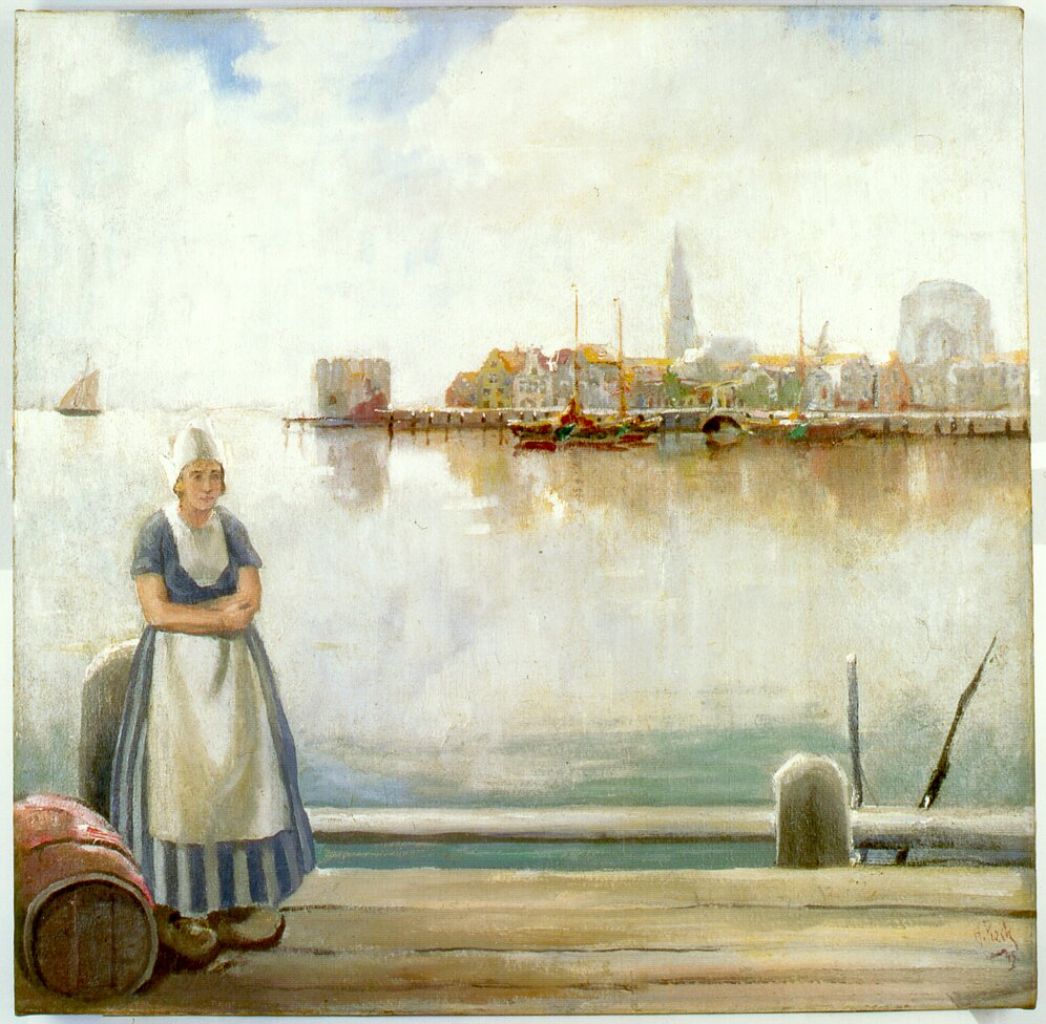
Unusual—almost square—in format, the painting depicts a seaport with landing piers, a barge, a boat setting sail and, blurred by a haze of water and clouds, an Old Dutch town silhouette of the seventeenth or eighteenth century featuring a church steeple and other prominent landmarks. In the foreground, a female figure wearing traditional Dutch garb catches the viewer’s attention. For the painter Henri Pieck, who had been an inmate in the Buchenwald concentration camp, she symbolizes the dream of going back to his homeland. After his return, he painted this scene as a way of expressing the longing he had felt for his native landscape and his family and his hope of regaining freedom and returning home.
According to the Buchenwald inmate Eugen Kogon, who would later author the book The SS State: The System of German Concentration Camps, “the SS officers demanded paintings of all kinds from the painters in custody. They were paid either nothing at all or merely a handful of cigarettes. It was not uncommon for the works’ ‘buyers’, on the other hand, to sell the paintings for nice sums to their acquaintances. Within the Buchenwald SS leadership there were at least two dozen valuable works, especially portraits, by the Dutch painter … Pieck. The artist did have the advantage of not perishing in some quarry or shaft detachment or other, but of working in his profession and establishing connections that saved him from death—if as a slave to these pathetic parvenus …”
This is the only known example of the Pieck’s Buchenwald art production. The owner was the former tropical physician in the Africa Corps of the German Wehrmacht in World War II, staff physician Dr Ernst Reichelt (1905–1967) from Hamburg. From February 1944 to March 1945, Reichelt worked at the “Serum Institute” of the Buchenwald concentration camp’s “Department of Epidemic Typhus and Virus Research of the Armed SS Hygiene Institute” and lived with his wife and five children in the village of Gaberndorf in the immediate vicinity of the camp. After the war he settled in Western Germany. Nearly thirty years after his death, his children donated the painting to the Buchenwald Memorial so that it would “manifest the stark contradiction to the secretly drawn images of the terrible reality”.
Biography
Henri Christiaan Pieck (Han Pieck) was born to a seafaring family in the northern Dutch seaport of Den Helder on 19 April 1895. As schoolboys, he and his twin brother Anton took drawing lessons. Anton would later become known throughout Holland for his Old Dutch motifs and winter scenes. Henri studied in The Hague and later at the Rijksakademie in Amsterdam and received his teaching licence. Then he followed the call of the wide world: in 1919 he was impressed by the Hungarian Soviet Republic. He began meeting with representatives of the Dutch labour movement and in 1921 designed a poster protesting the famine in the Soviet Union. An encounter with the painter Piet Mondrian encouraged him not only to work as a “free” artist, but also to dedicate his art to social aims. In the years that followed he designed numerous posters and became well-known as an exhibition architect. The Leipzig Trade Fair was one of his customers, and on behalf of the Dutch foreign ministry he created fair exhibitions in Liège, Geneva, London, Paris, and Madrid. Throughout these years he was also active in painting and graphic arts and produced an oeuvre in which nudes, cabaret scenes, and social issues are the predominant subject matter.
Henri Pieck was arrested in June 1941 because the illegal Communist newspaper De Vonk was produced in his studio in The Hague. He was deported to the Buchenwald concentration camp on 2 April 1942. There he was a member of the Dutch camp resistance group and the inner circle of the secret international camp organization leadership. He found a safe niche for himself in the labour detachment assigned to produce immunogens in “Virus Research Block 50”, a former inmates’ barrack which had been converted into a laboratory for the production of epidemic typhus vaccine. Political inmate functionaries such as Eugen Kogon helped him obtain painting commissions from the SS. He also drew and painted portraits of fellow inmates and secretly sketched the suffering he witnessed all around him.
After the war he reworked his sketches, and they were published in late 1945 by Het Centrum in The Hague and in 1949 by the VVN publishing company of Berlin and Potsdam in a portfolio. He is known to a wide public in Holland primarily through his cover designs for books for adolescents such as Pietje Bell and Dick Trom, cityscapes of Amsterdam and Paris, and his portraits. Henri Pieck died in The Hague on 12 January 1972.


